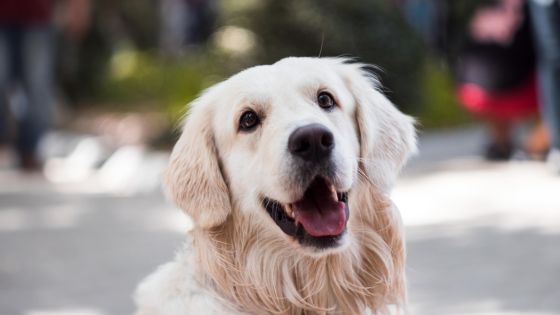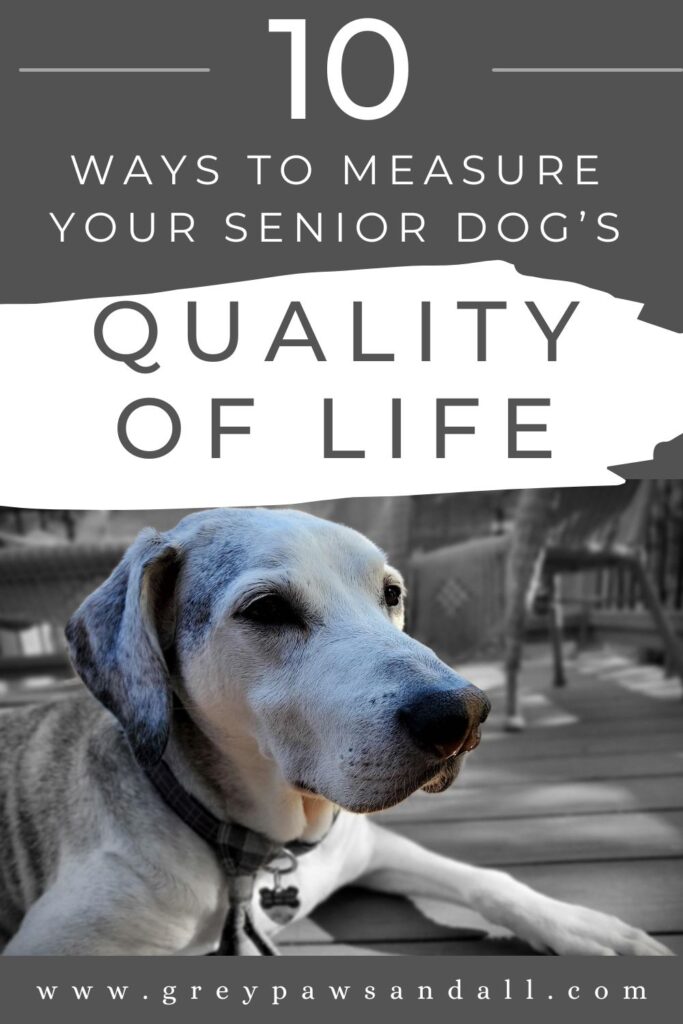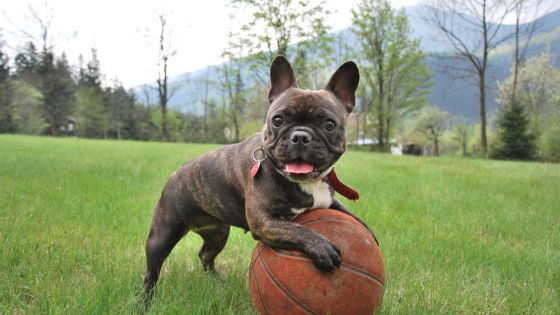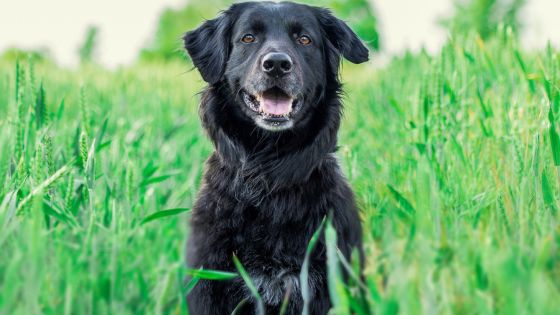Wouldn’t it be wonderful if assessing a dog’s quality of life was based on a straightforward formula. If… then…. In an emotionally detached way it could be, but we’re human with deep feelings for our furry companions, so it isn’t…and that’s what makes the decision to say goodbye feel impossible.
From evaluating physical and cognitive decline, to marking good and bad days on a calendar, there are lots of ways to measure your pet’s quality of life.
Make sure you read to the end, because I will mention specific assessment tools to help you.
Pet Quality of Life Assessment – Understanding the Signs of Aging in Dogs
Physical Changes
As dogs age, they often undergo various physical changes. Common issues include:
♦ Arthritis: Did you know, around 90% of dogs over 8 experience arthritis?
This article, Lifestyle Changes to Make Your Arthritic Dog More Comfortable will provide lots of helpful tips.
♦ Vision and Hearing Loss: It’s pretty common for senior dogs to experience varying degrees of vision and/or hearing loss. It often comes on so gradually, it’s not noticed until it’s quite advanced. That’s why you’ll often hear a senior dog parent say “it happened suddenly.”
Read this helpful article ⇒ A Guide to Caring for Your Blind Dog
Here’s another one! ⇒ How to Tell If Your Dog is Deaf
♦ Dental Issues: Nearly 80% of dogs have some form of dental disease by age three. Visit my Resource Page and scroll to the dental section for more information, including product recommendations.

Cognitive Decline
Canine Cognitive Dysfunction (CCD) is a real concern in older dogs, and is often referred to as dementia. Symptoms may include:
- Disorientation
- Altered sleep patterns (sundowning is when dogs sleep all day, and are up at night)
- Decreased interaction
- Circling
- Staring into space
According to a paper published in the National Library of Medicine called “Assessment of Risk Factors in Dogs with Presumptive Advanced Canine Cognitive Dysfunction” , one study describes that the prevalence of CCD in dogs 11–12 years of age was 28% and in dogs 15–16 years of age was 68%”
My heart dog Red had dementia, so I understand not only the challenges involved in caring for a dog affected, but even having it diagnosed.
Here are some articles I hope you’ll find helpful.
A Comprehensive Guide to Dog Dementia
Does Your Senior Dog Have Dementia
My Life as a Dog with Dementia
Behavioral Shifts
Pay attention to any shifts in behavior, no matter how minor you believe them to be. Common changes include:
- Increased anxiety or restlessness
- Altered sleep patterns
- Changes in appetite or food preferences
Assessing Your Dog’s Mobility and Physical Comfort
To evaluate mobility, consider a simple scoring system based on:
- Ease of rising from rest
- Ability to walk without assistance
- Capability to climb stairs or navigate obstacles
| Mobility Level | Description |
| Score 1 | Unable to rise or walk |
| Score 2 | Difficulties but can manage |
| Score 3 | Generally mobile with ease |
| Score 4 | Active and agile |
Pain Assessment
Observe for signs of pain such as:
- Whining or whimpering
- Limping or reluctance to move
- Changes in grooming habits
Pain management is essential, so consulting a veterinarian for appropriate treatment is crucial.
Comfort Measures
Enhancing your dog’s comfort can greatly improve their quality of life. Consider:
- Orthopedic beds for better joint support
- Ramps for easier access to furniture
- Joint supplements to alleviate pain

Monitoring Your Dog’s Appetite and Nutritional Needs
Appetite Changes
Be vigilant about any changes in eating habits. Red flags include:
- Reduced appetite
- Sudden picky eating
- Insatiable appetite
Keeping your dog at a healthy weight is vital. Obesity can worsen mobility issues and other health problems. Regular weigh-ins can help monitor changes.
If your dog is struggling with too much weight ⇒ How to Help Your Obese Senior Dog Lose Weight
Nutritional Adjustments
Adjusting your dog’s diet can enhance their quality of life. Recommendations to consider include:
- Switching to senior-specific food
- Diets tailored to your dog’s health condition (prescription/homemade/recipe created by holistic vet or canine nutritionist)
- Adding natural supplements for joint and cognitive health
Evaluating Your Dog’s Mental and Emotional Well-being
Cognitive Function
Simple cognitive tests can help assess mental acuity. Try:
- Asking familiar commands
- Observing if they remember routines
- Engagement and Interaction
Mental stimulation keeps your dog engaged. Activities like interactive games, puzzle toys, and gentle play can boost their spirits and well-being.
Social Behavior
Monitor your dog’s interactions with people and other pets. A decline in social behavior may indicate a drop in quality of life.
Seeking Veterinary Guidance and Support
Regular Veterinary Checkups
Routine checkups every 6 months (more often if dealing with a health challenge) are critical for older dogs. Regular evaluations can detect underlying health issues before they escalate. A problem caught early is easier to resolve or at least manage.
Diagnostic Testing
Tests like blood work, urine and x-rays can provide insights into your dog’s organ function. Early detection can lead to more effective treatments.
Treatment Options
Consult your vet about various treatment options available, including:
- Pain management medications
- Therapeutic interventions
- Special diets
Natural aging process or signs of a problem? Read this ⇒ 13 Signs Your Senior Dog Needs to See a Vet

Creating a Supportive and Enriching Environment
Adapting the Home Environment
Make your home more accommodating for a senior dog by:
- Removing obstacles that could cause falls
- Providing non-slip mats for safer movement
- Ensuring easy access to food and water
For tips on how to make your home more senior dog friendly…How to Make Your Home More Comfortable for a Senior Dog
Providing Mental Enrichment
Keeping your dog mentally active is essential. Engage them with:
- Puzzle toys that challenge their problem-solving skills
- Scent work to stimulate their natural instincts
- Teaching new tricks or brushing up on old ones
If bad weather prevents your dog from getting out as much as he’s used to, mental enrichment is even more important.
Read this ⇒ 17 Fun Ways to Entertain Your Senior Dog in Winter
Maintaining a Positive Relationship
Relationships with senior dogs require patience and understanding. Offering emotional support reassures them as they navigate their golden years.
Pet Quality of Life Assessment Tools
Everything written above was all about signs to help you determine how your dog is doing in various areas, and ways to make him or her more comfortable.
These are specific tools to use that will help you see things more clearl,y as your observations will be recorded and visible in “black and white” as it were.
Quality of Life Scale
The Quality of Life Scale also known as the HHHHHMM Scale, was created by Dr. Alice Villalobos, a veterinary oncologist. The letters stand for Hurt, Hunger, Hydration, Hygiene, Happiness, Mobility, and More Good Days than Bad
She started Pawspice, a quality of life program for terminal pets, and this scale was used to determine the success of care. Now it’s used by tons of senior pet parents to help them determine their pet’s quality of life.
Click this link to access the scale
Here is another scale, this one from the Lap of Love website
Daily assessment
As the name suggests, it is a tool that can be used daily. You can access it here.
Calendar
The calendar method is similar to the daily assessment in that it’s used every day. Rather than rate specific areas, at the end of each day (twice a day depending on the severity of your dog’s condition), mark on the calendar whether it was a good day or bad day.
At the end of the week or even a few days it will be very clear if there are more good days or bad days. When the bad outweigh the good, it is probably time to let go.
A calendar you can hang in the kitchen or other easy to access location, is best.
Conclusion
Recognizing key indicators of quality of life, can help you support your senior dog’s health and happiness. Regular veterinary care and proactive caregiving are essential in this journey. Enhancing your dog’s quality of life is a rewarding endeavor that truly enriches the bond you share. Invest in their well-being and watch them thrive in their later years.
I am a Senior Dog Care Consultant, helping senior dog parents struggling with anticipatory grief, quality of life and health & wellness issues. I offer practical tips, advice and one on one support. I am also a Certified Pet Loss Bereavement Specialist, helping you navigate through your pet loss journey.
Click this link to book a FREE 20 minute discovery call, visit my services page to find out more or email hindy@greypawsandall.com if you have any questions.
I’ve been rescuing and caring for senior dogs since 2009. From vision and hearing loss to obesity, dementia, kidney disease, liver issues, cardiac problems, Cushing’s, mobility challenges and more, you could say I’ve dealt with and learned a lot! In addition to my hands on experience, I’ve taken many courses and earned several qualifications to keep learning how to help senior dogs and they include: Senior Dog Enrichment, Understanding Canine Anxiety, Care of the Senior Pet and I’m a Certified Pet Loss Specialist.

